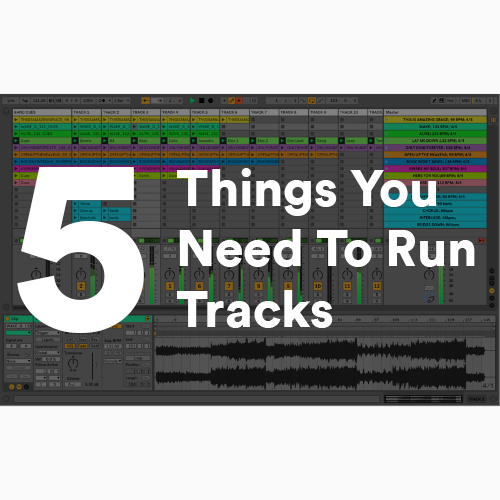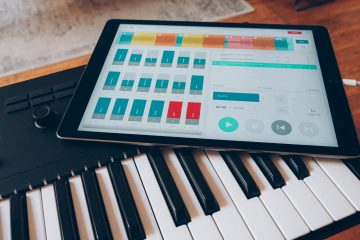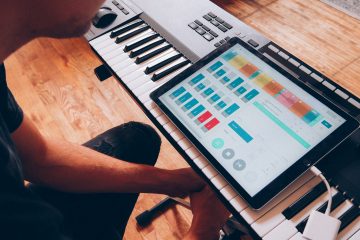5 Things You Need to Run Tracks In Worship

I don’t play along with tracks – I play tracks. There is a difference. Like my acoustic guitar, I see tracks as another instrument that I’m playing while leading worship. Some initially think that using tracks is limiting because it keeps you trapped to an arrangement, but it doesn’t have to be that way. With the right gear, you can take full control of your tracks and use them as a fresh creative expression of your worship band. My track rig has changed many times over the years, but there are a few pieces of gear that are essential for anyone who’s getting read to start playing tracks.
1. Tracks
This is an obvious one, but to run tracks you need to have tracks. When I first started playing with tracks, I created my own using Reason and GarageBand. I really enjoyed creating my own tracks because I was able to use creativity to produce my own versions of songs. It was also a great way to prepare for the weekend service because by the time I was finished, I knew the arrangements inside and out. If you don’t know how to produce your own tracks, there are many great places to purchase tracks online. I would recommend LoopCommunity.com. It’s more than a track store, it’s a community of worship leaders who are supporting each other in using technology in worship. They have thousands of tracks for just about any song you can think of at the most affordable prices out there. Loop also gives away tracks every month and it’s free to sign up.
2. Music Application
Once you have tracks for your songs, you need an app to run those tracks in. If you’re just getting started, I would suggest using a mobile app called Prime MultiTrack App. It’s completely free and works on macOS and iOS devices. You can customize your arrangements, change the key, adjust the tempo and more. Another great option is Ableton Live. There are three different versions of Ableton Live: Intro, Standard and Suite. If you’re looking to buy Ableton Live, I would recommend getting Live Intro for $99. You can always upgrade later if needed. Ableton Live is the leading software in the music industry for running tracks. Just like anyone who writes documents would know what Microsoft Word is, anyone who runs tracks knows what Ableton Live is. Both of these applications are excellent options with almost infinite abilities.

3. Audio Output Device
Getting the tracks connected to your sound system is the next step. The easiest way to do this is to use the headphone jack on your device. You can purchase a simple splitter cable that takes a stereo 1/8″ headphone jack and splits it to two mono 1/4″ jacks. In your music software, you simply pan the click to the left and the tracks to the right. Connect the headphone splitter to direct boxes or directly into your soundboard or stage snake. If you want to have more mixing control over each instrument track, you can use an audio output interface. Anything by MOTU or Focusrite is a solid interface, but I would recommend checking out TrackRig.com. Track Rig gives you 8 XLR outputs that you can route your tracks to. It’s an easy way to have multiple outputs when running tracks. There’s no wrong way here. I often use the headphone jack for simplicity and quick setup.
4. Controller
A piece of gear that takes playing tracks to a whole new level is a MIDI controller. This allows you to have full control of your tracks instead of the tracks having control of you. There are hundreds of great MIDI controllers out there. If you’re looking for a controller to use with your hands, I would recommend the Ableton Push, Novation Launchpad or Korg NanoKey. These are great controllers that let you assign buttons to different sections of songs, repeat the chorus or jump to a new song. If you’re looking for a hands-free option, I recommend the Looptimus Foot Controller. It’s a simple USB pedal that lets you control all of your tracks with your feet. Using a controller quickly turns tracks into another instrument in your band that you can play.
5. In-Ear Monitors
This one scares a lot of people. If you don’t have in-ear monitors at your church, the price-tag for a system can seem really intimidating. there are a lot of great options out there, some more affordable than others. I recommend checking out monitor systems by Behringer or Aviom first. If you can’t afford an entire monitor system, don’t worry! Just focus on getting the click and tracks to the person in your band who really needs to hear them. This could be the drummer or the music director. As long as the person in your band who is keeping time can hear them, everyone else can simply follow along. I led worship with tracks for five years without having in-ear monitors.
If you’re brand new to tracks, these are 5 things you need to get started. these tips will help you not only run tracks, but allow you to play tracks. If you want to learn more about using tracks in worship, sign up for my free online course at tracksinworship.com.
Matt McCoy



0 Comments